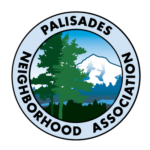
While supply lasts, one of our very own Palisades neighbors is giving away, for free, populated Mason Bee Houses! Send an email to lo.mason.bee@gmail.com to request a mason bee house (with hibernating bees) and arrange a time/location for pickup. First come, first served!
ABOUT MASON BEES
INTRODUCTION: Native mason bees are very docile and solitary, though they will nest in adjacent holes to one another. Every female is a queen and they live roughly 6 to 8 weeks. Mason bees are significantly more efficient pollinators than honeybees, but they only have about a 150 yard range versus the up to 2 mile coverage of honeybees. Mason bees do not make honey, nor will they drill holes. Instead, they seek existing holes to lay an egg, place a pollen ball for the youngster, and then seal it up with a mud wall. This is repeated until the hole is filled. The youngster needs the temperature cycles of the seasons to mature. During the fall, while still in the mud-capped chambers, they spin a cocoon and hibernate until springtime when they hatch and emerge as adults when temperatures are consistently in the mid 50F’s. Warm spells in spring can cause bees to emerge before flowers are available, but they can be refrigerated (with a humidity source) to delay emergence. Male bees have no stinger and female bees rarely sting unless significantly provoked (some say it feels like a light pinch – “oh” vs an “ow”.)
NESTING HOUSE: The mason bee house should be mounted somewhere between 4 to 8 feet high on a wall under some eaves to protect the house from direct rain as that might destroy the cardboard nesting tubes inside or damage the mud walls of the egg chambers. Each tube roughly holds 6 eggs. Ideally the wall is warmed by the morning sun and not exposed to strong wind. If you have milder spring temperatures, a south facing wall is good, but you do not want the nesting box to be exposed to high summer temperatures. (We mounted our nesting box at head height on a shaded south-facing wall, but it also gets some morning sun.) Also, placing the nesting house at least 10 feet from a doorway will help prevent bees from entering your house by accident. To help the bees locate their current tubes, small blocks of wood have been placed in the back of the box to give the tubes additional topology for navigation; that is, some tubes should stick farther out than others. Feel free to change the pattern! Mole holes, moist areas around gardens, or mud around bird baths typically provide mud sources. If you have an unheated garage or tool shed, you can move the nesting box inside once egg-laying activity stops and the adults for the season have died. This helps protect them from predators, such as parasitic wasps, mice, birds, raccoons, etc., but it is not necessary unless you anticipate that the temperatures will get too high by summer. After the bees emerge, they will reuse the tubes in good condition.
IMMATURE BEES: If your nesting house has mud-capped tubes, then those tubes have immature bees. Handle these tubes with care as the mud can be dislodged easily. Ten such (6” long) tubes means you will have 40-60 bees roughly and they can likely fill all of the remaining empty tubes in the nesting house in a single season.
FURTHER INFORMATION: The Internet is replete with mason bee information for your area. A good source of information and supplies is https://crownbees.com/ v1.0 2025 (no affiliation)
Installation
LOCATION: The bee house is not water proof, so hang it in a protected area
such as under eaves on the side of a shed or garage. Year-round locations
that have intense direct sun or a lot of wind should be avoided, but south or
southeast is a good exposure site in the spring. A good height is 5 to 7 feet
off of the ground to reduce predator access and make your viewing easier. If
the area gets direct sunlight in the summer, the house can be moved once
the adults finish laying eggs and no more bee activity is seen.
MOUNT: A screw is provided to aid in hanging the mason bee box using a
hook or keyhole mount, depending on the house. Drive the screw in so that
the head protrudes far enough from the surface to allow the mason bee
house to be hung or removed easily.


